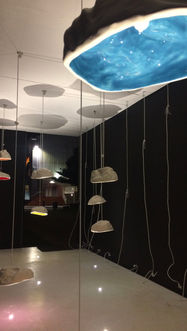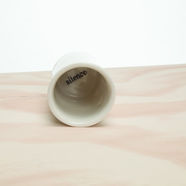Under The Bushel

Under The Bushel is an interactive light installation that plays with the absorption and reflection of coloured light, and the transformative effect light and colour has in a dark space.
Rock-like ceramic forms sit on the ground, attached to simple rope pulleys in an unlit space. As they are raised, the solid-looking rocks transform into colourful, empty bowls (bushels), their hollow interiors exposed. They each release a glow of coloured light reflected from the inside of the bushel onto the shiny white floor. Then as the forms are raised higher, the full white light is released into the space so it is brightly and warmly lit. The forms create shadows until they reach the top and their bright coloured interiors decorate the ceiling, contrasting to their solid presence on the ground.
The work brings to life the proverb ‘don’t hide your light under a bushel’ illustrating the transformative effect of sharing hidden talents. The transformation rests in the hands of the viewers and the level of light they wish to contribute. The space is at its brightest only when every member of a full room of viewers contributes fully to releasing the light.
Under The Bushel was installed as part of the LUX light festival in Wellington, New Zealand in 2017 and true to its theme, was made possible by the collective contributions of others.
Making Conversations

This series of works explores the importance of discourse and the positions of speaker/writer and addressee/listener in the formation of relationships with the other, and in consequently developing an identity in relation to the other. Drawing from personal conversations and relationships, the work asserts the value of dialogue with the other but equally explores the difficulty of words, of making conversation, and of truly relating to the other.
This body of work resulted in a final installation featuring works that focused on personal conversation, or rather attempts at conversation. These works highlight the paired and interchanging roles of speaker and listener, I and you. If an identity as I is defined by being a speaker, then do we lose our own identity in the absence of an other? The listener can be seen as giving another a voice and allowing another to have an identity.
The mug is used as a familiar, personal object associated with conversations and with comfort. Using a slip casting method these mugs were remade from a personal mug collection, but altered. Closed, empty, broken, connected or missing essential parts (a handle), the mugs can be seen as personifications. The alterations that remove the mugs’ function as drinking vessels lessen their identity as mugs. They reflect the difficulties of making meaningful conversation and the lack of identity one has without this exchange.
These alterations also highlight the other function of objects: as simply something to hold onto. This is emphasised even more in the handles and The Spaces Between, porcelain objects cast between the hands of two people, which make the space itself an object, something to hold onto. Like comfort objects, these mugs and porcelain forms suggest the presence of people and words while also emphasising their absence.
































